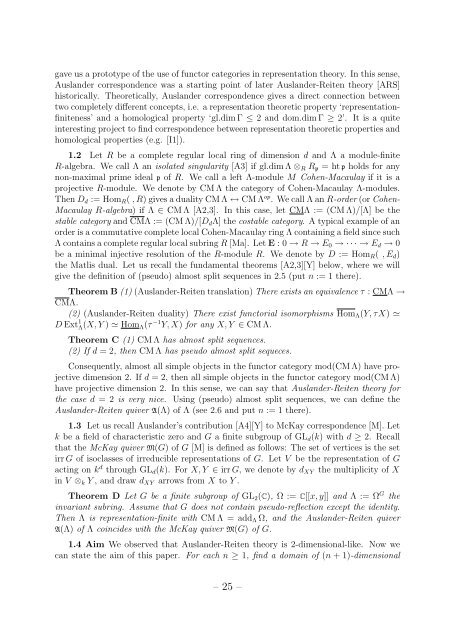HIGHER DIMENSIONAL AUSLANDER-REITEN THEORY ON ...
HIGHER DIMENSIONAL AUSLANDER-REITEN THEORY ON ...
HIGHER DIMENSIONAL AUSLANDER-REITEN THEORY ON ...
You also want an ePaper? Increase the reach of your titles
YUMPU automatically turns print PDFs into web optimized ePapers that Google loves.
gave us a prototype of the use of functor categories in representation theory. In this sense,<br />
Auslander correspondence was a starting point of later Auslander-Reiten theory [ARS]<br />
historically. Theoretically, Auslander correspondence gives a direct connection between<br />
two completely different concepts, i.e. a representation theoretic property ‘representationfiniteness’<br />
and a homological property ‘gl.dim Γ ≤ 2 and dom.dim Γ ≥ 2’. It is a quite<br />
interesting project to find correspondence between representation theoretic properties and<br />
homological properties (e.g. [I1]).<br />
1.2 Let R be a complete regular local ring of dimension d and Λ a module-finite<br />
R-algebra. We call Λ an isolated singularity [A3] if gl.dim Λ ⊗ R R p = ht p holds for any<br />
non-maximal prime ideal p of R. We call a left Λ-module M Cohen-Macaulay if it is a<br />
projective R-module. We denote by CM Λ the category of Cohen-Macaulay Λ-modules.<br />
Then D d := Hom R ( , R) gives a duality CM Λ ↔ CM Λ op . We call Λ an R-order (or Cohen-<br />
Macaulay R-algebra) if Λ ∈ CM Λ [A2,3]. In this case, let CMΛ := (CM Λ)/[Λ] be the<br />
stable category and CMΛ := (CM Λ)/[D d Λ] the costable category. A typical example of an<br />
order is a commutative complete local Cohen-Macaulay ring Λ containing a field since such<br />
Λ contains a complete regular local subring R [Ma]. Let E : 0 → R → E 0 → · · · → E d → 0<br />
be a minimal injective resolution of the R-module R. We denote by D := Hom R ( , E d )<br />
the Matlis dual. Let us recall the fundamental theorems [A2,3][Y] below, where we will<br />
give the definition of (pseudo) almost split sequences in 2.5 (put n := 1 there).<br />
Theorem B (1) (Auslander-Reiten translation) There exists an equivalence τ : CMΛ →<br />
CMΛ.<br />
(2) (Auslander-Reiten duality) There exist functorial isomorphisms Hom Λ (Y, τX) ≃<br />
D Ext 1 Λ(X, Y ) ≃ Hom Λ (τ −1 Y, X) for any X, Y ∈ CM Λ.<br />
Theorem C (1) CM Λ has almost split sequences.<br />
(2) If d = 2, then CM Λ has pseudo almost split sequeces.<br />
Consequently, almost all simple objects in the functor category mod(CM Λ) have projective<br />
dimension 2. If d = 2, then all simple objects in the functor category mod(CM Λ)<br />
have projective dimension 2. In this sense, we can say that Auslander-Reiten theory for<br />
the case d = 2 is very nice. Using (pseudo) almost split sequences, we can define the<br />
Auslander-Reiten quiver A(Λ) of Λ (see 2.6 and put n := 1 there).<br />
1.3 Let us recall Auslander’s contribution [A4][Y] to McKay correspondence [M]. Let<br />
k be a field of characteristic zero and G a finite subgroup of GL d (k) with d ≥ 2. Recall<br />
that the McKay quiver M(G) of G [M] is defined as follows: The set of vertices is the set<br />
irr G of isoclasses of irreducible representations of G. Let V be the representation of G<br />
acting on k d through GL d (k). For X, Y ∈ irr G, we denote by d XY the multiplicity of X<br />
in V ⊗ k Y , and draw d XY arrows from X to Y .<br />
Theorem D Let G be a finite subgroup of GL 2 (C), Ω := C[[x, y]] and Λ := Ω G the<br />
invariant subring. Assume that G does not contain pseudo-reflection except the identity.<br />
Then Λ is representation-finite with CM Λ = add Λ Ω, and the Auslander-Reiten quiver<br />
A(Λ) of Λ coincides with the McKay quiver M(G) of G.<br />
1.4 Aim We observed that Auslander-Reiten theory is 2-dimensional-like. Now we<br />
can state the aim of this paper. For each n ≥ 1, find a domain of (n + 1)-dimensional<br />
– 25 –















